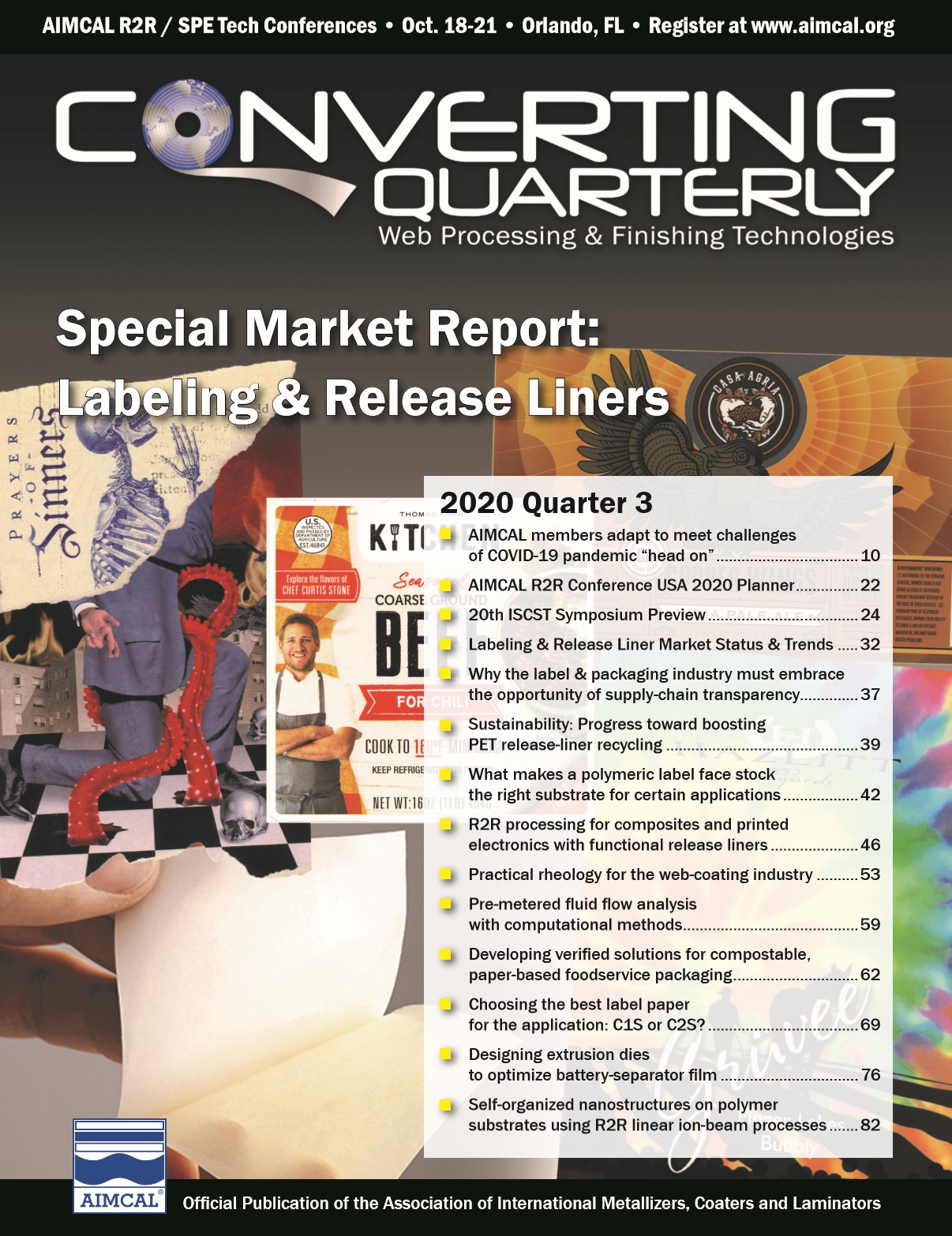As published in Converting Quarterly in Quarter 3, 2020 by E.J. (Ted) Lightfoot, Ph.D., principal, Ted Lightfoot LLC.
Abstract
The flow behavior of liquid coatings can be more complicated than most people learned in college.
Rheology, the science of how materials deform and flow under stress, has a well-earned reputation for complexity. But, in the coating industry, we often have to deal with things we don’t fully understand. This article explains the most common effects you can expect and what to watch for in the solution-mixing area.
Introduction
Introductory fluid mechanics uses simple models. Newton’s law of viscosity says shear stress is equal to the viscosity times the shear rate, and we learn that flow can be driven by shear (one surface moving relative to another) or by pressure. This is a very elegant picture, and many useful correlations can be derived from it – such as the flow rate through a tube or a filter being proportional to the pressure drop. Unfortunately, many coatings are complex fluids that do not follow these simple rules (as in pressure drop not being proportional to flow). There are many kinds of coatings and many nuances to their rheological behavior [1]. Ideally, R&D should tell you what kind of material you are coating and what kind of behavior to expect, as well as provide a measurement system that allows you to detect when things change. But, that doesn’t always happen. Three common non-Newtonian effects can be seen in the plant: viscosity that is a function of shear, yield stresses and normal stress effects . Careful attention to detail often can tip you off to what you are dealing with – and if there are problems, it’s time to talk to a rheologist.
Types of non-Newtonian behavior
Variable viscosity: The simplest effect that deviates from Newton’s law of viscosity is an apparent viscosity that varies with shear rate [2]. The most common effect is seeing the apparent viscosity drop with increasing shear rate. This is called “shear thinning” behavior or pseudoplastic behavior (some people use pseudoplastic for one specific form of shear thinning). Polymer solutions and colloidal coatings (coatings containing particles including latex, emulsions, dispersions or suspensions) commonly are shear-thinning. With shear-thinning fluids, as the flow rate goes up, the shear rate goes up with it. Because the apparent viscosity drops at a higher shear rate, the increase in pressure drop will be less than proportional to flow rate.
The opposite behavior – shear thickening or dilatancy – also is possible [3]. Simple shear thinning or thickening behavior is independent of time and history. If you set a rotational viscometer to a given speed, you should get the same result every time. Cup viscometers often are used for quality-control purposes; however, with shear-dependent viscosity, a viscometer that provides a controlled shear rate (the higher-end Brookfield viscometers are the least expensive common option) will show you a lot more. The most common correlation for shear-dependent liquids is the power law model:

The units of consistency are dependent on the power n, so to control-chart the data, estimate n from a few batches and record the batch-to-batch consistency estimated using the standard
power for that product.
Viscosity also can vary with shear history. Thixotropic liquids decrease in viscosity as they are sheared; rheopectic liquids increase in viscosity as they are sheared. Thixotropy is very common in colloidal coatings. To check for thixotropy (or rheopexy), start a rotational viscometer at low shear (speed) and record the viscosity as you first increase, then decrease the shear rate. This is called a thixotropic loop. If you see hysteresis in the measurement, the material is thixotropic or rheopectic. If you don’t have a rotational viscometer, watch what happens to the mix as it stirs. If it thins out when stirred, it is thixotropic.
Yield stress: The most familiar thixotropic liquid is ketchup: If you shake ketchup, it becomes fluid. But, if you open a full bottle of ketchup, invert it and wait for it to come out, it may not. This is referred to as having a yield stress; up to a certain shear stress, the material acts (more or less) like a solid, not a liquid, and above that, it acts as a liquid. Many colloidal coatings are shear-thinning, thixotropic and exhibit yield stresses. A rheologist can measure different types of yield stress. A practicing engineer can observe yield stresses three ways. First, look for ketchup-like resistance to drainage. Second, look for disturbances on the surface of the coating that do not heal. Third, if you measure viscosity (the average of the increasing and decreasing shear values) vs. shear rate, extrapolating the shear stress (apparent viscosity times shear rate) back to zero shear rate gives an estimate of the yield stress.
Many coatings with low-shear Brookfield viscosities in the thousands of centipoise thin down on shear until they reach a constant high-shear viscosity in the tens of centipoise. These often can be fit with the Casson equation:

where μ∞ is the high-shear viscosity (a constant). The yield stress you estimate from the Casson equation is not as good as the measurements a rheologist will make – it is an attempt to extract properties of a quiescent fluid from a fluid under shear. But, it often is good enough for control-charting tasks. The other advantage of the Casson equation is that coating nips tend to have high shear (hundreds to hundreds of thousands of reciprocal seconds), so the high-shear plateau viscosity μ∞ is a reasonable viscosity to use for understanding web coatability.
Normal stress effects: The most bizarre, fluid-mechanical phenomena you can observe come from “normal stress differences” in viscoelastic fluids. Not all non-Newtonian fluids exhibit normal stress differences; only viscoelastic materials do. Polymer melts and solutions are well known to exhibit viscoelasticity, and the best overview of the effects they cause is in a book on polymeric liquids [4]; however, colloidal systems also can be viscoelastic. Numerous videos on the Internet show these effects, including a classic from 1965 [5]. Fluids exhibiting the most extreme viscoelastic effects cannot be coated – such as liquids that can be poured out of a beaker but pull back in when the beaker is righted. This behavior can be observed in the mix area with reactive coatings that have exceeded their shelf life.
Figure 1 illustrates a normal stress difference. For a simple shear flow between two plates, the “1” direction is the direction in which the top plate is moving. The “2” direction is the direction in which the velocity varies, and the “3” direction is coming out of the page toward you.

If you look at a cubic, fluid-volume element somewhere in the flow, for Newtonian liquids, the fluid exerts a pressure on each face of the cube (balanced by the pressure exerted by the liquid outside the cube). If the cube is small enough, the pressure on each face is the same. But, for a flowing viscoelastic fluid, the force on the faces depends on the orientation of the face. The difference (t11 – t22) is the first normal stress difference; the difference (t22 – t33) is the second normal stress difference. If the forces on the faces are different, how do you measure the pressure? How you mount a pressure transducer will influence the reading you get [4].
Recognizing a viscoelastic fluid
Understanding viscoelastic fluid mechanics is not a realistic expectation for folks in the coating industry but recognizing when you have a viscoelastic fluid is. If you insert a spinning rod into a Newtonian liquid, you will create a vortex. If you insert the same spinning rod into a viscoelastic fluid, the fluid will try to climb the rod. Academics visualize this with smooth rods. Industry uses rods with impellers on the end and, without proper baffling, mixing can lead to a vortex. Figure 2 shows that, even in an unbaffled beaker with an axial mixer, viscoelastic solutions can climb shafts of mixers. Watching for rod climbing is not a reliable substitute for a good rheological characterization, but it is something to watch in the mixing area.

Some people report that a first, normal stress difference stabilizes coating; others report that it destabilizes coating. But, one thing is certain: Changing normal stress differences will change the coating window. For example, cross-linking adhesives have limited pot lives. As they age, they become more viscoelastic, and you also can see them starting to climb the shaft of the agitator. You will see the coating window change as this happens. Combining those observations can be useful in setting the pot life of reactive systems. In addition, it may give you a quick read on how much viscoelasticity you can handle.
Conclusion
If you are coating significantly non-Newtonian liquids, you probably want to consult a rheologist to understand what is going on. But, watching for three things: pressure drop vs. flow rate, yield stresses and rod climbing in a mix kettle can tell you when it is time to make that call.
References
1. Ronald G. Larson, The Structure and Rheology of Complex Fluids, New York: Oxford University Press (1999)
2. Peter Schweizer, “Viscosity vs. rheology,” Converting Quarterly 2016 Q3, pp 86-89
3. To experience a shear thickening liquid, mix two cups of cornstarch with one cup of water to make “oobleck” – often used to entertain children.
4. Chapter 2 of R. Byron Bird, Robert C. Armstrong and Ole Hassager, Dynamics of Polymeric Liquid, 2nd ed., Vol. 1
5. H. Markovitz, Rheological Behavior of Fluids, https://youtu.be/ Ol6bBB3zuGc
E.J. (Ted) Lightfoot, principal consultant at Ted Lightfoot LLC, worked for DuPont for over 35 years in the photographic business, casting, coating and laminating fluoropolymer and optical films (as well as some emerging technologies that remain proprietary). His experience in R&D, plant support, as a Six Sigma Black Belt for Growth, and application development (helping customers develop processes and structured products) gives him a balanced perspective on what it takes to build a robust supply chain. Lightfoot consults, writes, speaks and teaches short courses. He can be reached at 716-449-4455, email: ejl@TedLightfoot.com, www.TedLightfoot.com.
Original online article can be found here.


